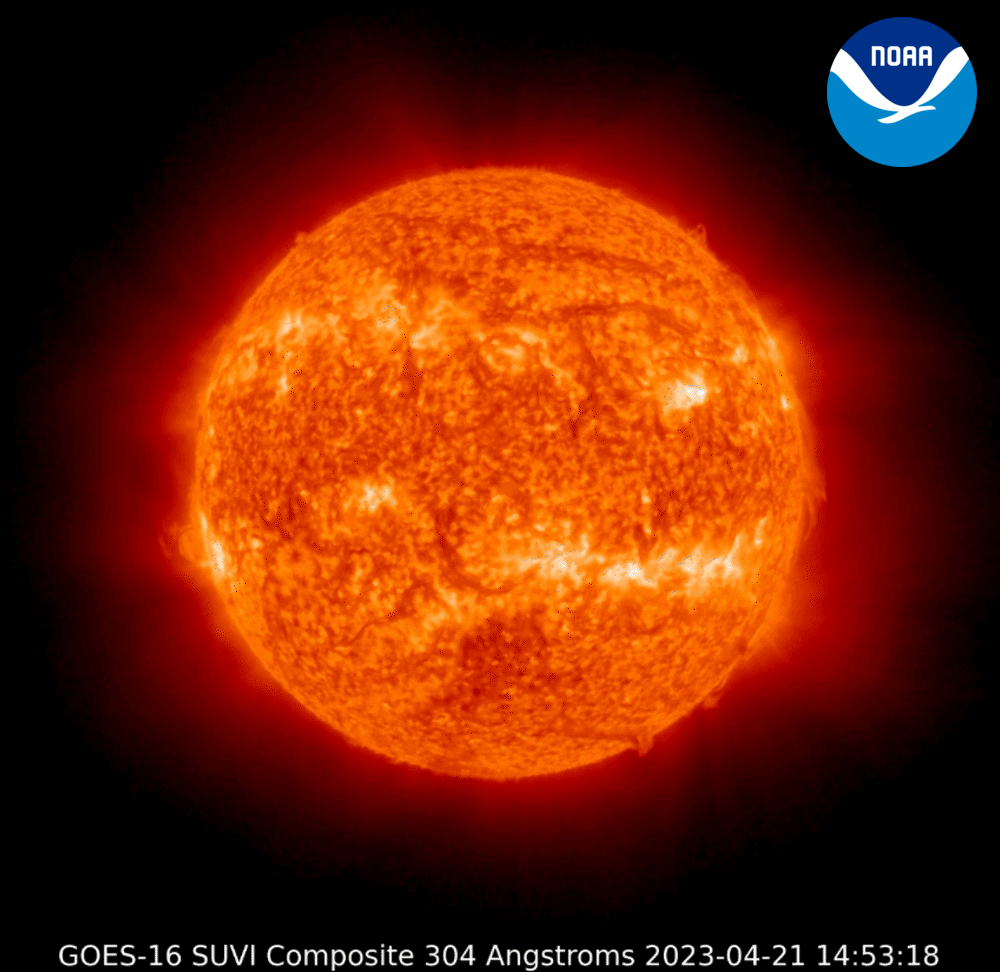
Posted on 07/25/2023 11:02:51 AM PDT by Lockbox
December 2019 marked the beginning of Solar Cycle 25. The Sun’s activity has quickly ramped up and even though we haven’t reached peak levels in this cycle, the Sun’s activity is already exceeding predictions. Solar events will continue to increase as we near solar maximum in 2025, and our lives and technology on Earth, as well as satellites and astronauts in space, will be impacted.
(Excerpt) Read more at blogs.nasa.gov ...
The predictions are wrong. Just goes to show humans that they can predict all they want, but the cycles don’t always match predictions. The cycles rhyme, but they are still not alwats precise.
December 2019 marked the beginning of Solar Cycle 25. The Sun’s activity has quickly ramped up and even though we haven’t reached peak levels in this cycle, the Sun’s activity is already exceeding predictions. Solar events will continue to increase as we near solar maximum in 2025, and our lives and technology on Earth, as well as satellites and astronauts in space, will be impacted.
NASA’s Heliophysics Division is developing a mission that will provide crucial advances in our understanding of the ionosphere-thermosphere (I-T) system – the Geospace Dynamics Constellation (GDC). This mission will provide the first coordinated global-scale observations of the I-T region, where the effects of solar activity are often seen. The I-T region is a part of Earth’s upper atmosphere that extends up to about 400 miles altitude and includes low-Earth-orbit, where the International Space Station and many commercial and governmental satellites reside. The I-T system is a region that affects our technological society in many ways, from creating interference in radio signals to generating large electric currents in power distribution systems. The GDC mission’s study of the global, coupled system will enable dramatic improvements in our space weather models, which will lead to the mitigation of negative effects on space-based, air-based, and ground-based assets.
A More Active Solar Maximum
During the Sun’s natural 11-year cycle, the Sun shifts from relatively calm to stormy, then back again. At its most active, called solar maximum, the Sun is freckled with sunspots and its magnetic poles reverse. (On Earth, that would be like if the North and South Poles flip-flopped every decade.) During solar minimum, on the other hand, sunspots are few and far between. Often, the Sun is as blank and featureless as an egg yolk.
The Solar Cycle 25 Prediction Panel, an international group of experts co-sponsored by NASA and NOAA, predicted that this would be a below-average solar cycle, like the one before it – Solar Cycle 24. However, the Sun has been much more active this cycle than anticipated. The cycle is aligning more with a study from a team lead by Scott McIntosh of National Center for Atmospheric Research, published in Solar Physics.
With more activity comes an increase in space weather events including solar flares and solar eruptions, which can impact radio communications, electric power grids, and navigation signals, as well as pose risks to spacecraft and astronauts. We have an increasing dependence on space-based technology and ground-based infrastructure that are susceptible to the dynamic nature of space. For many new commercial and government stakeholders, this already stronger-than-expected solar cycle will be the first they navigate.
During Solar Cycle 26, the GDC mission will be able to provide valuable insight that isn’t available during this solar maximum.
Space Weather & Global Impacts
There are more than 35,000 objects orbiting in the ionosphere-thermosphere region around our planet, including the International Space Station, weather and communications satellites, and other operational government assets, with many more being launched each year. When the ionosphere-thermosphere system is pummeled by solar and geomagnetic activity, these assets are adversely affected. For example:
Variable satellite drag due to atmospheric heating modifies spacecraft operations and orbits. This can cause satellites to reenter Earth’s atmosphere prematurely, decrease satellite lifetimes, increase the risk of orbital collisions, and cause spacecraft to be out of optimal position for their mission.
Radiofrequency communication and navigation capabilities are degraded.
GPS positioning experiences errors due to the ionospheric disturbances (in plasma density) that occur on regional scales (a continent or larger).
Space-to-surface transmission noise is increased. This affects military monitoring of the north polar region and communications globally.
During times of geomagnetic activity, the near-polar regions experience high fluxes of radiation in the form of energetic particles. These particles can travel to low altitudes, where they become a concern for airplane flight crew and passenger health.
When intense electrical currents driven by space weather flow overhead in the I-T system, they can produce enormous “mirror” currents in power lines and pipelines. These currents can damage or destroy critical infrastructure, leading to expensive power outages or maintenance and repair costs.
The key to making dramatic improvements in our ability to predict and mitigate such events lies in finally understanding Earth’s ionosphere-thermosphere system. This is the heart of the local space environment: all processes active in near-Earth space start, end, or are modified there. Despite its importance, this transition region is the aspect of Earth’s space environment that is least understood as a global system.
It is necessary to prioritize missions that will improve on the lack of measurements in the ionosphere-thermosphere system to better mitigate space weather impacts on national infrastructure and support the national needs of the operational agencies. Recent events have highlighted the need to observe and better understand the variable density and drag that satellites encounter. With real-time data from a mission like GDC, mission operators can better protect satellites affected by space weather activity.
NASA’s Space Weather Program will provide a framework to ensure that the GDC data can be quickly ingested into operational systems in partnership with NOAA and other agencies. The NASA Space Weather Program will provide the needed modeling support for satellite operations and facilitate the real-time downlink capability for appropriate space-based platforms. Additionally, the NASA Space Weather Program will facilitate coordination with partner agencies to incorporate their complementary ground-based measurements throughout the solar cycle.
By Nicola Fox, Director of NASA’s Heliophysics Division
Hmmm.... Not one word about warming or cooling. Says a lot.
Shhh! The Global Warming Science is Settled™!

Solar warming? Who knew? Better implement some “dei” and “esg” programs STAT!. They of course won’t DO anything but someone will feel real good.
https://www.swpc.noaa.gov/products/solar-cycle-progression
It’s an absolute mystery
All we can do is watch and read what the MSM oracles inform us. Do not dare to question them.
We must appease and genuflect. Everything is our fault and Western Civilization must be debased and even destroyed to secure our salvation in their eyes.
Forty two trillion dollars must be paid to to atone for our sin of having a petroleum based economy.
The article seems like a lot of words just to say, “Give us more money.”

The sun is the major source of heat for the planet. If the sun emits more energy, we get warm.
The news articles on “climate change” never mention the sun.
I doubt that spending more millions on sensors will do anything to ameliorate the sun’s effects.
Of course. And I'd let them have it on the condition that they quit pumping the climate change hysteria.
NASA does science like the CDC does health.
They predicted this solar cycle to be just like the last one.
But now they know this one is going to be stronger.
Is there any indication that it is going to be stronger than it used to be? I did not see it in the article.
I don’t know. I had really high expectations of solar cycle 25. Much higher than 24.
Comms up on 10 Meters. CQ DX CQ DX
Is Solar cycle 25 better than Peloton?
“The news articles on “climate change” never mention the sun.”
Nor do they mention the overall solar system temps either. Which also fluctuate with the solar minimums and maximums.
Solar cycle 25 is an aspiring rapper. High expectations indeed.
Disclaimer: Opinions posted on Free Republic are those of the individual posters and do not necessarily represent the opinion of Free Republic or its management. All materials posted herein are protected by copyright law and the exemption for fair use of copyrighted works.